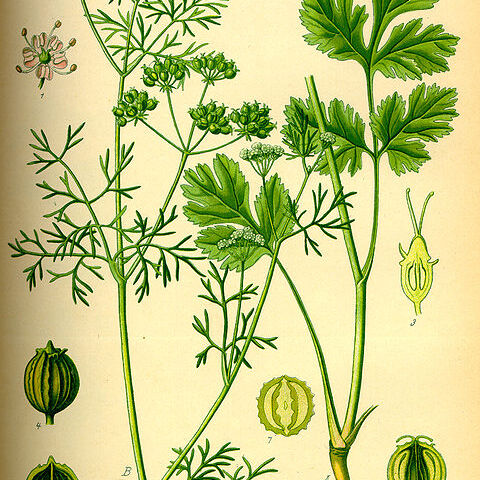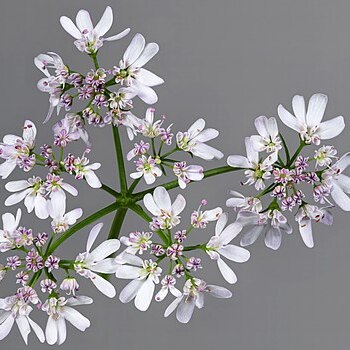Herbs annual, strongly aromatic, glabrous throughout. Taproot slender. Stem erect, branched above. Leaves petiolate; blade pinnately dissected, membranous; ultimate segments very variable in shape. Umbels compound, lax, terminal or opposite the leaves; bracts absent (rarely 1); rays several, spreading, unequal; bracteoles several, linear. Calyx teeth short, acute, often unequal. Petals white or rose-pink, obovate, apex deeply notched, outer petals enlarged (radiant). Stylopodium conic; styles slender, erect. Fruit globose, not readily separating at maturity; pericarp hard; primary and secondary ribs filiform, evident; vittae absent or solitary, obscure in mature fruits. Seed face concave. Carpophore deeply bifid at apex.
Fr subglobose, hard, scarcely separable into mericarps; primary and secondary ribs about equally developed, low, narrow, obtuse; oil-tubes none; carpophore bifid to the base; umbels terminal and lateral, compound, with 3–8 rays; invol none or of one narrow bract; umbellets small, few-fld; bractlets 3, small, linear, all at the outer side of the umbellet; sep unequal, those toward the periphery of the umbellet much the larger; pet white, pink, or purple, obcordate, the outer ones of the peripheral fls much the larger; stylopodium conic; annuals with pinnately decompound lvs. 2, Medit.
Glabrous annual herbs. Lvs 1-3-pinnate or ternate; segments broad or narrow. Umbels compound, pedunculate; bracts 0-1, simple; bracteoles few, simple. Petals white or pink, irregular with outer larger and deeply 2-lobed; apex inflexed; calyx teeth evident, unequal, acute. Fr. ovoid or globose, hard, terete, not beaked, spineless; commissure broad; ribs 9 per mericarp, low, somewhat unequal, secondary broader than primary; vittae solitary, inconspicuous in mature fr.
Fruit suborbicular, the mericarps tending to remain joined, even at maturity. Ribs slender, and low; vittae absent or obscure; carpophore divided to the base.
Leaves thin and membranous, mostly finely dissected (in F.Z. species the basal leaves broadly lobed and strikingly different from the upper ones).
Petals white to pinkish with a clearly inflexed tip, the outer ones of the umbels noticeably radiate.
Stylopodium conical; styles long and slender, with a slight terminal stigmatic enlargement.
Inflorescence of terminal and lateral, few-rayed compound umbels.
Calyx teeth obvious and relatively large, often rather unequal.
Slender, glabrous annual herbs with narrow taproots.
Seed somewhat concave on the inner face.


